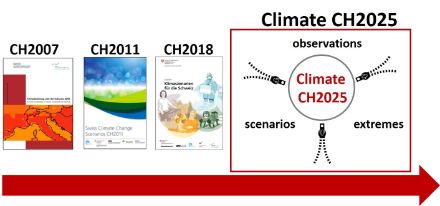Service Navigation
Search
The latest findings on past and future climate change in Switzerland will be presented at the opening event of Climate CH2025 on 4 November 2025, from 4:30 p.m., at ETH Zurich.
Please register to participate on the following page:
Centre for Climate Systems Modelling - C2SM (in German)

National climate scenarios are an important basis for the public and private sectors to plan and design adaptation and mitigation measures. Regional or local assessments of future climate change are therefore an important climate service.
The "Climate CH2025" project is based on the Federal Council's mandate to the Federal Office of Meteorology and Climatology MeteoSwiss to provide regularly updated climate scenarios as part of the federal government's adaptation strategy. The climate scenarios are developed together with the main partner ETH Zurich and other institutions under the umbrella of the National Centre for Climate Services (NCCS).
Motivation
In 2018, the current edition of the Swiss climate scenarios CH2018 was published. These scenarios show that a further increase in mean temperatures is expected as climate change progresses. The impacts of climate change in Switzerland can be summarized in four key statements: higher incidences of heat extremes, more precipitation extremes, drier summers, and snow scarce winters. The extent of these changes depends strongly on the assumed future development of greenhouse gas emissions.
Since the CH2018 scenarios were published, both the science and the needs of users have evolved. New science, as documented in the recent IPCC report (AR6), has been published, and new high-resolution and convection-permitting climate models have been developed. Thanks to the continuous involvement of users in the design of the scenarios, MeteoSwiss and ETH were able to gain a detailed picture of the requirements for future climate and climate change information.

Aims of Climate CH2025
The Climate CH2025 project, launched in March 2023, addresses identified gaps in existing climate scenarios and additional requirements. Like previous generations of climate scenarios, the current project is a collaboration between MeteoSwiss, ETH Zurich, and other partners from science and government. The results of Climate CH2025 will build on the existing CH2018 scenarios and extend them with new scientific knowledge and products.
Two main scientific issues will be in focus:
- How can observations and model-based climate scenarios be better integrated to provide consistent and temporally comprehensive information to users in a way that meets their needs?
- What is the expected future development of climate extremes in Switzerland and what are the underlying processes?
Over Western and Central Europe, the temperature has risen more sharply since 1980 than projected in the regional climate models that form the basis for CH2018. There are two main explanations for this: On the one hand, air quality - worldwide, but also in Europe - has improved significantly since the 1980s, meaning that the concentration of aerosols in the air has decreased. As a result, less sunlight is scattered back, causing the atmosphere to heat up more (brightening effect). This was not directly taken into account in previous models (e.g. Wild, 2012). On the other hand, natural fluctuations in the climate may play a significant role.
The Swiss climate scenarios CH2018 are currently being revised as part of the "Climate CH2025" project. In the new scenarios, the effects of circulation changes and aerosol emissions are also to be better taken into account so that the model projections better reflect the observations of the past and present.
According to the provisional results, the core statements of CH2018 will not change qualitatively: In Switzerland, we expect drier summers, an increase in extreme precipitation, more hot days and heatwaves and winters with less snow in the future. Quantitatively, the local changes expected in the future for given scenarios will probably be more pronounced.
The final quantifications will be published in the Climate CH2025 products at the end of the project (end of 2025).
References:
Schumacher, D.L., Singh, J., Hauser, M. et al. Exacerbated summer European warming not captured by climate models neglecting long-term aerosol changes. Commun Earth Environ 5, 182 (2024). https://doi.org/10.1038/s43247-024-01332-8
Wild, M. (2012). Enlightening global dimming and brightening. Bulletin of the American Meteorological Society, 93(1), 27-37.